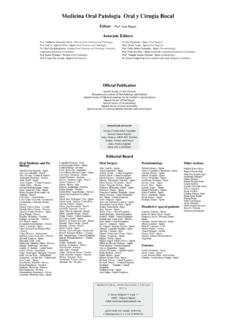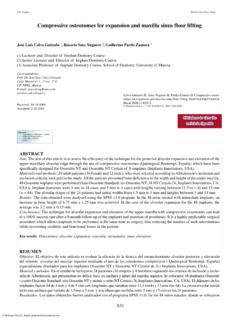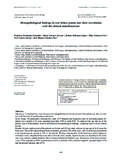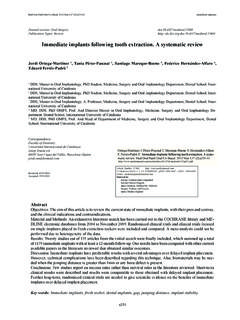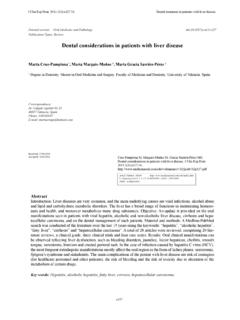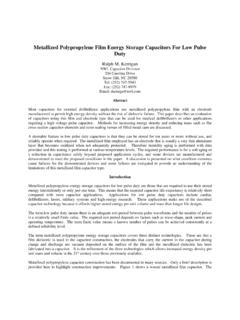Transcription of Composite resins. A review of the materials and …
1 E215 Med Oral Patol Oral Cir Bucal 2006;11:E215-20. Composite resins Clinical Dentistry Composite resins Composite resins. A review of the materials and clinical indicationsAdela Herv s Garc a, Miguel Angel Mart nez Lozano, Jose Cabanes Vila, Amaya Barjau Escribano, Pablo Fos Galve Lecturers in Dental Pathology and Therapeutics. Cardenal Herrera-CEU University. Moncada. ValenciaCorrespondence:Dra. Adela Herv s Garc aFacultad de Ciencias Experimentales y de la SaludEdificio Odontolog aC/ del Pozo s/n46115 Alfara del PatriarcaValenciaE-mail: 4-12-2005 Accepted: 29-01-2006 Herv s-Garc a A, Mart nez-Lozano MA, Cabanes-Vila J, Barjau-Escri-bano A, Fos-Galve P.
2 Composite resins. A review of the materials and clinical indications. Med Oral Patol Oral Cir Bucal 2006;11:E215-20. Medicina Oral S. L. B 96689336 - ISSN 1698-6946 ABSTRACTThe aim of this work is to present the different components of the composites currently used in dentistry and furnish dentists with a basis that can provide criteria for choosing one or another to suit their therapeutic requirements. Most composites used in dentistry are hybrid materials , so-called because they are composed of polymer groups reinforced by an inorganic phase of glass fillers with different compositions, particle sizes and fill percentages. Flowable or conden-sable composites have attempted to provide an answer to certain functional requirements, although they have not been too successful at improving properties.
3 Turning to polymerisation initiators, both halogen lamps, whether conventional or high intensity, and LED curing lights which provide a gradual increase in light intensity are very useful for reducing shrinkage of the Composite material. The clinical choice of a Composite must consider whether priority should be given to mechanical or aesthetic requirements: if mechanical considerations are paramount the material with the greatest volume of filler will be chosen; if aesthetic considerations predominate, particle size will be the most important factor. Additional components such as opaques and tints make it possible to improve the aesthetic results. Equally, the spread of other therapeutic procedures, such as tooth bleaching, has made it necessary to design Composite materials in shades that are suitable for the special colour situations found in teeth treated by these words: Composite resins, inorganic filler, organic matrix, polymerisation, clinical applications.
4 RESUMENEl objetivo de este trabajo es presentar los diferentes componentes de los composites actualmente utilizados en Odon-tolog a y aportar al profesional las bases que puedan proporcionarle los criterios a tener en cuenta para seleccionar uno u otro en funci n de los requerimientos terap uticos. La mayor a de los composites de uso en Odontolog a corresponden a materiales h bridos, se denominan as por estar conformados por grupos polim ricos reforzados por una fase inor-g nica de vidrio de diferente composici n, tama o y porcentaje de relleno. Los composites fluidos o los condensables han tratado de dar respuesta algunos requerimientos funcionales, aunque sin demasiado xito en la mejora de sus pro-piedades.
5 Respecto a las fuentes de polimerizaci n, tanto las l mparas hal genas, convencionales o de alta densidad de potencia, como las LEDs, que ofrecen un incremento gradual de la intensidad lum nica, son muy tiles para disminuir la contracci n volum trica del material. A la hora de la selecci n cl nica de un material compuesto se valorar si priman los requerimientos mec nicos o los est ticos; en el primer caso seleccionaremos el material que tenga mayor volumen Indexed in: -Index Medicus / MEDLINE / PubMed -EMBASE, Excerpta Medica-Indice M dico Espa ol -IBECS Medicina Oral Email: here to view the article in SpanishE216 Med Oral Patol Oral Cir Bucal 2006;11:E215-20.
6 Composite resins Clinical Dentistry Composite resins Med Oral Patol Oral Cir Bucal 2006;11:E215-20. Composite resins Clinical Dentistry Composite resins de relleno, mientras que en el segundo ser el m nimo tama o de part cula el factor m s importante. La existencia de elementos adicionales como los opacificadores y tintes, permite mejorar los resultados est ticos con estos materiales. As mismo la generalizaci n de otros procedimientos terap uticos, como son los blanqueamientos dentales, a comportado la necesidad de dise ar materiales compuestos con tonos que se adecuen a las situaciones de color especiales que presentan los dientes tratados con estos clave: Resinas compuestas, relleno inorg nico, matriz org nica, polimerizaci n, aplicaciones cl nicas.
7 INTRODUCTIONC omposite resins have been introduced into the field of conservative dentistry to minimise the drawbacks of the acrylic resins that replaced silicate cements (the only aes-thetic materials previously available) in the 1940s. In 1955, Buonocore used orthophosphoric acid to improve the adhe-sion of acrylic resins to the surface of the enamel. In 1962 Bowen developed the Bis-GMA monomer in an attempt to improve the physical properties of acrylic resins, as their monomers only allowed linear chain polymers to be formed (1). These early, chemically cured composites required the base paste to be mixed with the catalyst, leading to problems with the proportions, mixing process and colour stability (2).
8 From 1970, Composite materials polymerised by elec-tromagnetic radiation appeared, doing away with mixing and its drawbacks. At first, an ultraviolet light source (365 nm) was used to provide the required light energy, but its shallow polymerisation and iatrogenic side-effects led to its replacement by visible light (427-491 nm), which is currently in use and undergoing further development (3). Composi-te development has been and continues to be unceasing, making it necessary to keep abreast continually. The aim of this work is to present the different components of the composites currently used in dentistry and furnish dentists with a basis that can provide criteria for choosing one or another to suit their therapeutic OF PRESENT DAY COM-POSITESThe physical, mechanical and aesthetic properties and the clinical behaviour of composites depend on their structure.
9 Basically, dental composites are composed of three che-mically-different materials : the organic matrix or organic phase; the inorganic matrix, filler or disperse phase; and an organosilane or coupling agent to bond the filler to the organic resin. This agent is a molecule with silane groups at one end (ion bond to SiO2) and methacrylate groups at the other (covalent bond with the resin) (4).The organic matrix of Composite resins is made up, in essence, of a system of mono-, di- or tri-functional mo-nomers; a free radical polymerisation initiation system, which in photocurable Composite resins is an alpha diketone (camphoroquinone) used in combination with a tertiary aliphatic amine reducing agent (4-n,n-dimethylamino-phen-yl-ethanol, DMAPE) and in chemically-curable ones is a per-compound, benzoyl peroxide, used in combination with an aromatic tertiary amine (n,n-dihydroxyethyl-p-toluidine).
10 An acceleration system (dimethylaminoethyl methacrylate or DMAEM, ethyl-4-dimethylaminobenzoate or EDMAB, or N,N-cyanoethyl-methylaniline or CEMA), which acts on the initiator, allowing curing to take place in a clinically acceptable time; a stabiliser or inhibitor system such as hydroquinone monomethyl ether to maximise the product s storage life prior to curing and its chemical stability thereaf-ter; and, lastly, absorbers of ultra-violet wavelengths below 350 nm, such as 2-hydroxy-4-methoxybenzophenone, to provide colour stability and eliminate the effects of UV light on the amine compounds in the initiator system that can cause discolouration in the medium to long term (5).The monomer system can be viewed as the backbone of the Composite resin system.
